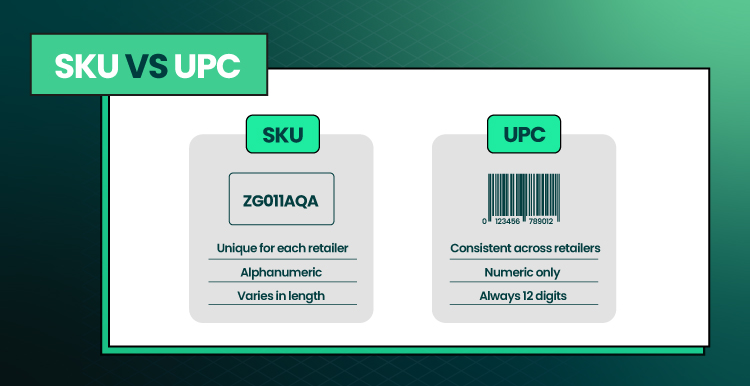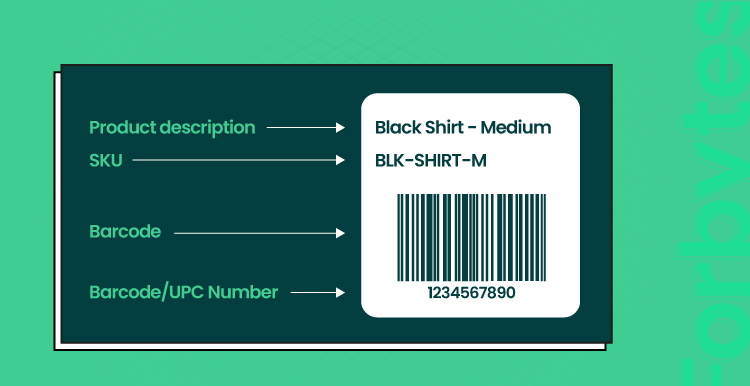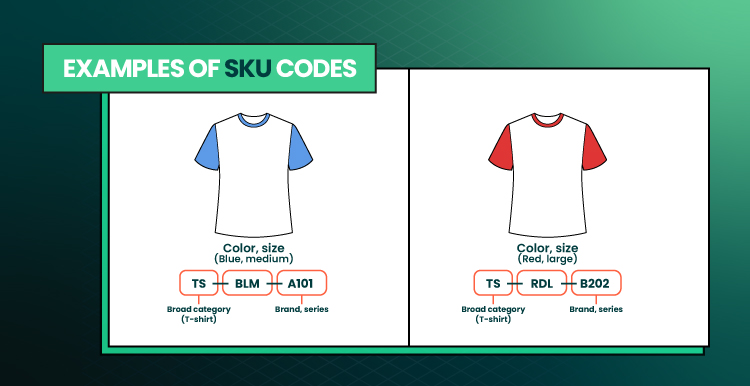On the one hand, merchants should offer a wide product assortment. This helps them increase the chances that clients will stay with them for a long time and keep ordering from them. On the other hand, the inventory distortion in 2020 led to a $580 million loss for retailers. What’s more, having a lot of products available at the warehouse means a lot of management workload for the staff. You need to leverage an effective inventory management strategy to prevent mistakes, delays, and cross-team misunderstandings. And this is when the idea of creating an SKU may first come to your head.
We are Forbytes, an e-commerce software development company that helps clients across the globe solve their business challenges with technology. If you are interested in SKU code creation and SKU management and are looking for a quick product SKU guide, keep reading.
What Does Product SKU Mean?
What is SKU? SKU stands for Stock Keeping Unit. To put it simply, this is a code that marks a particular item. SKUs are used to manage and keep records of the retailer’s inventory. An SKU number exists to help retailers differentiate between their items in a convenient and standardized way. As a rule, SKUs mark the specific characteristics of an item such as size, price, color, brand, and so on.
When a customer buys an item, a manager scans it in the PoS system (point of sale) and the item is removed from the stock. Hereafter, the item’s SKU is automatically removed from the SKU system.
No matter if you are an online, offline, or multichannel business — an SKU system will be a helpful instrument for every retailer as it assists with sales data. SKUs are used by e-commerce businesses, offline shops, catalogs, and warehouses for inventory management. With the help of SKU numbers, retailers track inventory and prevent overstocking and understocking. They can easily track products and make sure that items that are in high demand are always available for customers. Usually, SKUs are scannable and allow merchants to keep their online and offline stock systems in sync.
SKU vs. UPC
If you create SKUs in the right way, there will be no identical SKUs in your system. Each SKU is unique, and two different items cannot be marked with the same SKU number. At the same time, these two items can have the same UPC or barcode. These are other identification codes used by online retailers. Let’s discuss UPC in more detail.
Unlike SKU, UPC, or Universal Product Code, is not specific to your business. These are universal codes that consist of 12 characters and identify a manufacturer and item. UPC codes consist of numbers only. They are used globally and universally. When creating SKU, keep in mind the information below to make sure that your SKU and UPC are different.

What if you decide to save your time and use UPC codes as SKUs? As a rule, it’s better to create an SKU that differs from a UPC. This is because a universal product code is for external use and does not consider extra characteristics that are vital for your supply chain management. For example, the supplier’s name. If you have it in your SKU, your management team will get quick access to stock information. They will also be able to organize the supply chain effectively. If you use UPC codes as your SKU, you will lack this data. The same goes for the order of items and the number of items in stock. Universal Product Codes won’t give you this information. In most cases, it’s ineffective to use UPCs as your SKUs.
SKU vs. Barcode
The terms UPC and barcodes are used interchangeably. They mean the same thing but in different forms. UPC code is a numerical code while a barcode is a visual code. It’s the combination of black lines that are scanned by a merchant at the point of sale when clients purchase orders. A barcode is also universal and cannot substitute SKUs.

Example of SKU Codes and the Use of SKUs in E-Commerce
There’s no universal approach when it comes to creating an SKU. That’s because each merchant sells a stock that is unique to their business. Suppose that there is a clothing store that creates an SKU based on four item characteristics. The first two letters of their SKUs mark the item category (skirt, dress, shirt). The next two mark the style (oversized, standard, slim fit). The last two denote color and size. For example, BL-36 will mean blue color and 36 size. Here’s the SKU that a merchant would get based on this description: DR-OS-BL-36 (Dress-Oversized-Blue-36), which means an oversized blue dress of size 36.

Another example of an SKU can be one created by a multi-brand shoe store. For example, to mark brown Nike sneakers of size 6, the retail store can use the SKU “NK-SN-BR-06.” The data on the number of items can also be added as a continuation of this Stock Keeping Unit. This could help the store’s managers to track the availability of these sneakers and catch the time when the new supply should be ordered.
5 Benefits of Using SKU Numbers
Product SKU helps online retailers differentiate and track the items of the same category. On the one hand, a product’s own unique SKU gives merchants information on the category that is common for identical products. On the other hand, SKUs also show data that is unique for each item. Implementing different SKUs can forever change your business and streamline stock management. Since nearly 60% of retail businesses still lack supply chain visibility, automating SKU creation and SKU management can also give you a powerful competitive advantage.
With the help of stock-keeping units, you can:
Organize stock management
SKUs are not used for the sake of being used. They are helpful signs for managers who can look at an SKU product and get all essential data from it. A great part of this data is about stock availability and internal tracking. These days, more than 60% of supply chain managers complain about the lack of supply chain visibility. By assigning a unique SKU code, you make sure that your team gets a clear understanding of the state of your inventory management and knows when it’s the right time for restocking. Modern inventory management systems automatically assign product SKUs and send notifications when an item is out of stock.
Conduct accurate demand analysis
With a unique SKU code, you can maintain a healthy demand-supply balance. SKUs will help you get a clear picture of sales you get during different seasons, track inventory and stock levels, spot the need for restocking, etc. To make SKUs more informative in terms of demand analysis, add the data to SKUs that the customers are interested in. You’ll be able to sort the items according to these characteristics and see how the metrics determine the demand.
Generate more profit
Product SKU will give you sales data on the products that are in high demand. Knowing what your customers want from your retail store will increase your sales. However, do not perceive demand data as a direct sign that you should get rid of low-selling products. Almost every business has such products in stock. You shouldn’t refuse to sell them at all. Instead, you need to have a healthy variety of stock that includes both low-selling and high-selling items. Your goal is to make this variety profitable for your business. Check our e-commerce tips for growing e-commerce businesses that may help you generate creative solutions for your problem.
Increase client retention
An SKU number can be used to make forecasts on client behavior. Your team will be able to identify items that are reordered frequently. Such data can be used for making effective product recommendations and sending personalized ads to your customers. Besides, many products are ordered interchangeably. By analyzing your SKUs, you will identify products of this kind. When one of such products is out of stock, the system will suggest a similar product to a client. The high chance is that they will make a new order and stay with you for longer.
Facilitate customer experience
With the help of SKUs, customers get the service they want quickly and effectively. Before digital transformation changed the retail industry, it was hard for managers to keep a stock record manually. For example, there was a furniture store selling a wide variety of products. Not all colors, shapes, and sizes were represented in the store — many of them were waiting in the warehouses. When a client came to the store and asked a manager to check the availability of a product of a particular size or color, the manager had to check dozens of spreadsheets manually. It took a lot of time and effort and frequently led to mistakes. Today when such a situation happens, all the manager has to do is scan an SKU code with a scanner and automatically see all the data on the given product and all possible modifications that are available. So, using SKUs improves the client experience as they get all answers to the questions in a matter of seconds.
How to Create SKU (Stock Keeping Unit)
As noted by Harvard Business Review, ineffective inventory management is one of the top reasons why startups fail. By creating a product SKU, you will improve stock and inventory tracking and facilitate your interaction with customers and suppliers. But before assigning an SKU to each item you sell, you need to prepare a foundation for this. This foundation is called SKU architecture.
Product SKU usually consists of 8-12 characters. Do not make them longer as it will be harder for your managers to interpret them. At the same time, try not to make them shorter. Shorter SKUs will be less informative — so try to stick to the recommended number of characters.
A typical architecture of an SKU code can include the following characteristics:
- Manufacturer or supplier;
- Department;
- Store locations or sales channels;
- Item size/type/brand/color;
- Sequence number.
The data included in a stock-keeping unit can be subdivided into 3 main parts. The first part of an SKU is the most important one. It marks the determining characteristic of an item such as a supplier, category, etc. Try to limit this part to 2 or 3 characters that will start an SKU code. Also, try to mark the first part of an SKU in letters to allow managers to interpret an SKU quickly.
The next part of a Stock Keeping Unit represents more specific (or unique) characteristics. These may be the color, size, manufacturer, or other subcategories. The final part of SKU management marks a sequence identifier that demonstrates the order in which you purchased products from a supplier or the number that tells you how many items you have in stock.
Here are some extra tips for creating SKU numbers that will be informative and easy to interpret:
- Maintain hierarchy. When creating an SKU, start by outlining the general information. This can be a product category or supplier or brand. Move from general to specific — it will be much easier for your team to manage the stock. When dealing with identical items, all they will have to do is look at the SKU’s ending and get important information on each item.
- Avoid letters that resemble numbers. And numbers that look like letters. For instance, it’s quite risky to use “0” (zero) in a Stock Keeping Unit. Zero resembles the letter “O” a lot. It can lead to mistakes and misinterpretations by your team. When looking for a particular item in the SKU system, they will type in a number instead of a letter and find no items. But in fact, these items will be in stock.
- Avoid using special characters, punctuation signs, and symbols. Instead of spaces, you will use dashes in Stock Keeping Units. As for special characters and symbols, different systems may find it difficult to read them. So, it’s better to stick to the traditional, alphanumeric approach to creating SKUs.
Sure, the capacities of modern technologies allow you to automate the process of SKU creation. If you are a scalable business that plans to effectively manage inventory, manual SKU management is not an efficient decision. Sooner or later, you or your employees may end up with SKU duplicates and mistakes. To prevent this from happening, build a product management system for your business. Product management systems automate SKU generation and assign it to each item added to your database.

Create an Effective SKU System with Forbytes
At Forbytes, we understand that a well-structured SKU system is essential for efficient inventory management and smooth operations. Our team of experts is here to help e-commerce businesses develop custom systems tailored to your unique needs. Whether you’re just starting or looking to optimize your existing SKU management, we’ve got the tools and expertise to guide you every step of the way.
Have any questions or need help implementing an effective SKU system? Don’t hesitate to reach out—we’re here to assist!

Our Engineers
Can Help
Are you ready to discover all benefits of running a business in the digital era?

Our Engineers
Can Help
Are you ready to discover all benefits of running a business in the digital era?








